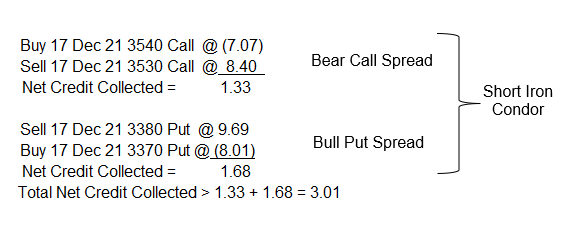In true Quadruple Witching form, this week’s turbulent price action was highlighted by some exceptionally violent rips and dips.
As this first chart in today’s report shows, the S&P 500 is still locked in a range of roughly 3.0% defined by the all-time highs on the high-end and the 12/06 to 12/07 overnight gap-up on the low-end.
Figure 1

One of the great things about options trading is that there is a strategy fit for every type of market environment.
And when it comes to range-bound markets, there’s more than one.
Today, I am going to show you how I implemented an “iron condor,” which is one of the easiest multi-leg options strategies to learn, on Amazon (AMZN). In addition, I am going to share how I managed this trade after getting stopped out of a portion of the trade for a loss.
Why use an Iron Condor?
Traders would use this strategy if they feel the price of a stock is poised to remain within a certain price range over a certain period of time.
This trade is also used when a trader wants defined risk, with relatively strong odds of success.
Although these trades have a good success rate, the tradeoff is that the profit potential is limited.
What does this trade look like?
As part of my Total Alpha service, I use a lot of “credit vertical spreads” such as “bull put spreads” and “bear call spreads.”
I like to use these trades not just because of their high success rate and limited downside risk, but also because they are the easiest multi-leg options strategies to understand.
That’s because they involve simply selling a higher-priced put and buying a lower-priced put (bull put spread) or selling a higher-priced call and buying a lower-priced call (bear call spread), all with the same expiration date. You’ll see what I mean in Figure 2 below.
Well, to construct an iron condor you simply combine both of these trades in a manner that establishes a price range that the trader feels the underlying stock price will not exceed.
On the next chart, you can see that I’ve used my actual AMZN trade parameters to demonstrate this.
Figure 2

What’s the maximum profit potential?
The most a trader can make on this trade is equal to the amount of credit (i.e., the spread) collected when the trade was constructed.
Here’s some more detail:
You can see from the simple math behind this trade shown below that by creating a net credit of 1.33 by constructing the bear call spread and a net credit of 1.68 by creating a bull put spread, the maximum profit potential for the trade equals the combined credit of 3.01 at expiration.

What’s the maximum loss potential?
The most a trader can lose on this trade is equal to the difference between the strike prices of the bull put spread (or bear call spread) minus the net credit that was collected when the trade was constructed.
When does this trade reach maximum profit potential?
The maximum profit on the trade is reached when, at expiration, the price of the underlying stock closes equal to or below the call that was sold and above the put was sold, allowing the spread to expire worthless, which means the trader has collected all of the credit collected when the spread was created.
When does this trade reach maximum loss potential?
Well, the answer to this question is a bit more complex because there are two possible outcomes in which the maximum loss is realized.
First, if shares of the underlying stock close below the lowest strike price at expiration, that causes the calls to expire worthless, but both puts are in the money. As a result, the bull put spread reaches its maximum value and maximum loss.
Second, if shares of the underlying stock close above the highest strike price at expiration, that causes the puts to expire worthless, but both calls are in the money. As a result, the bear call spread reaches its maximum value, causing the trader to suffer maximum loss.
Where is the breakeven price?
Again, the answer here is twofold:
First, the lower breakeven level is where the stock price equals the strike price of the short put minus the net credit received.
Second, the upper breakeven point is where the stock price equals the strike price of the short call plus the net credit received.
How does volatility effect an Iron Condor?
The ideal environment for entering this trade is when volatility is at elevated levels, and, perhaps more importantly, when the trader expects volatility to start falling shortly after entering the trade.
Why?
Because the elevated volatility prior to entering the trade will allow options premiums to become expensive, which will allow the trader to collect a higher credit when entering the trade by selling for a net credit.
From there, if volatility falls according to plan that will allow the options premium to fall rapidly, which is the goal since the trader wants the value of the spread he or she created to decay to zero.
How does time affect the trade?
If you sell an iron condor, you like to watch paint dry.
Trust me when I tell you in this business, that’s a good thing, as the passage of time is what helps give trades like this their high success rate.
This is because a short iron condor spread has a net positive “theta,” which means the trade benefits from time decay as long as the stock price is in the range.
How did I manage this trade this week?
You will have plenty of losing trades throughout your career, but knowing when to cut the cord on these losers early is the key to victory.
With that said, I decided to exit the bull put spread portion of this trade at a loss on Thursday in order to avoid maximum loss at expiration on Friday.
I did this because, as you are able to see on Figure 2 above, AMZN started to push below the 3380 Put strike that I sold.
What you can also see on Figure 2 is that AMZN remained below the 3530 strike price of the call that I sold to create the bear call portion of the iron condor.
Since I held on to the bear call portion of the Iron condor through Friday’s expiration, that portion of the trade expired worthless, which means it closed at its maximum profit.
How does a trader stop out of a credit spread?
In the case of the bull put spread portion of my iron condor trade that I stopped out of on Thursday, I simply reversed the order which I used to enter the trade.
Specifically, to open the original bull put spread portion of the trade, I sold to open (STO) the 3380 put and bought to open (BTO) the 3370 put. Therefore, to stop out of that trade, I reversed this order and bought to close (BTC) the 3380 put and sold to close (STC) the 3370 put.
Bottom Line
But managing a trade is not always just about stopping out of a losing position and crying about it.
You have to learn to move on to new opportunities quickly.
That’s precisely what I did in this case, as I jumped into the Wall Street Octagon to alert members to the fact that I was entering a new 3290/3280 bull put spread in AMZN at a credit of $2.50, which I quickly closed half of @ $1.50, then the rest @ $.30.
It’s like Apollo Creed told Rocky Balboa in Rocky III, “There is no tomorrow.”
Pick your head up, refocus and move on if you want to become a successful trader.
To YOUR Success!





